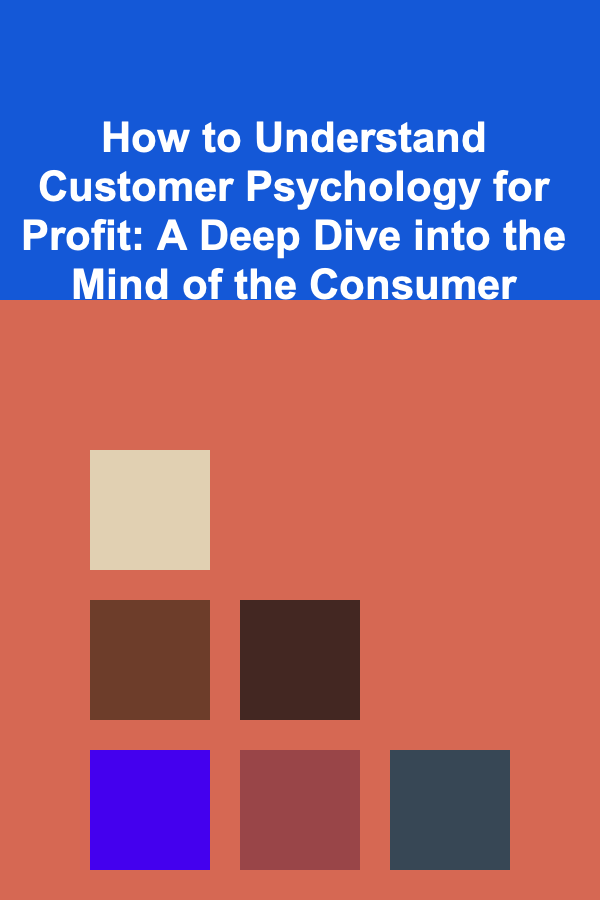
How to Understand Customer Psychology for Profit: A Deep Dive into the Mind of the Consumer
ebook include PDF & Audio bundle (Micro Guide)
$12.99$6.99
Limited Time Offer! Order within the next:

In the relentless pursuit of profit, businesses often focus on product features, pricing strategies, and marketing channels. While these elements are undeniably crucial, they merely scratch the surface of what truly drives commercial success. The deepest, most enduring competitive advantage lies not in what you sell, but in understanding why people buy. This profound insight into human behavior, desires, and decision-making processes is the essence of customer psychology. It's the master key to unlocking sustainable growth, forging lasting relationships, and ultimately, maximizing profitability.
This comprehensive article will delve into the intricate world of customer psychology, dissecting the foundational principles, exploring key psychological concepts, outlining methodologies for gaining insights, and demonstrating practical applications across various business functions. We will unveil how a nuanced understanding of the human mind transforms guesswork into strategy, converting mere transactions into meaningful, profitable engagements.
The Indispensable Role of Psychology in Business
At its core, every business transaction is a human interaction. Whether it's a B2B sale, a retail purchase, or a subscription renewal, people are making choices based on a complex interplay of conscious thoughts, unconscious biases, emotions, and past experiences. Without understanding these underlying drivers, businesses operate in a vacuum, making assumptions that often lead to misguided efforts, wasted resources, and missed opportunities.
Profitability, at its heart, is a function of delivering value that resonates with customers. This resonance isn't just about functionality; it's about addressing needs, fulfilling aspirations, alleviating pain points, and evoking positive emotions. Psychology provides the framework for deciphering these intricate human dimensions. It shifts the focus from simply selling a product or service to understanding the customer's world, their problems, and their desired outcomes.
Consider the difference between a company that haphazardly designs its website and one that meticulously optimizes every click based on user behavior patterns, cognitive load, and visual hierarchy. Or the difference between a sales team that merely lists features and one that frames solutions in terms of benefits that speak directly to the customer's deepest motivations. These are the tangible impacts of applied customer psychology, leading directly to higher conversion rates, increased average order value, enhanced customer loyalty, and reduced churn -- all direct contributors to the bottom line.
Foundational Principles of Customer Psychology
To truly understand customer psychology, we must first grasp some fundamental tenets of human behavior. These principles serve as the bedrock upon which all other psychological insights are built.
1. Humans are Primarily Emotional Beings (Even When We Think We're Rational)
Despite our self-perception as logical decision-makers, neuroscience confirms that emotions play a dominant role in purchasing decisions. Research by Antonio Damasio, for instance, showed that people with damage to the part of the brain that processes emotions struggle to make even simple decisions. Emotions like joy, fear, excitement, anxiety, trust, and even disgust can sway a customer towards or away from a purchase. A product might be logically superior, but if it doesn't evoke positive feelings or alleviate negative ones, it may fail in the marketplace.
2. The Unconscious Mind is a Powerful Driver
Much of our decision-making happens below the level of conscious awareness. Cognitive biases, heuristics (mental shortcuts), and ingrained habits significantly influence choices without us even realizing it. Businesses that understand these unconscious triggers can subtly guide customers towards desired actions, not through manipulation, but by aligning with inherent human tendencies.
3. Needs, Wants, and Desires Dictate Behavior
Drawing from Maslow's Hierarchy of Needs, customers seek to fulfill basic physiological needs, safety, belonging, esteem, and self-actualization. Products and services that effectively tap into these fundamental human motivations, whether explicit or implicit, create deeper connections. A luxury car isn't just transportation; it can fulfill needs for status (esteem) or self-expression (self-actualization). A security system addresses the need for safety.
4. People Seek to Minimize Risk and Maximize Reward
Every purchase involves perceived risk -- financial risk, performance risk, social risk, psychological risk. Customers are constantly evaluating whether the potential benefits outweigh these risks. Businesses can leverage this by offering guarantees, social proof, clear value propositions, and excellent customer service to mitigate perceived risks and amplify perceived rewards.
5. Context Matters Immensely
The environment, the framing of an offer, the timing, and even the surrounding messaging can drastically alter a customer's perception and decision. The same product might be viewed differently depending on whether it's presented as a limited-time offer, a premium item, or a budget-friendly alternative.
Key Psychological Concepts and Their Business Applications
Now, let's explore specific psychological concepts and how they manifest in customer behavior, offering actionable insights for businesses seeking profit.
1. Cognitive Biases: The Mental Shortcuts That Influence Decisions
Cognitive biases are systematic patterns of deviation from norm or rationality in judgment. They are mental shortcuts our brains use to process information quickly, but they can lead to predictable errors. Understanding and leveraging (ethically) these biases can profoundly impact marketing, sales, and product design.
-
Anchoring Bias: People rely too heavily on the first piece of information offered (the "anchor") when making decisions.
Business Application: Present a higher-priced item or package first to make subsequent, lower-priced options seem more reasonable (e.g., displaying the "premium" plan before the "standard" one). Or, establish a high perceived "original price" before applying a discount.
-
Framing Effect: How information is presented influences choices. People react to a particular choice in different ways depending on how it is presented; as a loss or as a gain.
Business Application: Focus on what customers gain rather than what they lose (e.g., "Save $50" vs. "Don't miss out on $50 in savings"). Frame features as benefits (e.g., "Our product saves you 2 hours a week" vs. "Our product has automation features").
-
Scarcity Principle / Fear of Missing Out (FOMO): Perceived rarity or limited availability increases demand and value.
Business Application: "Limited stock," "Only X left," "Offer ends soon," "Exclusive access," "Limited edition." This creates urgency and compels quicker decisions. E-commerce sites frequently use this with stock counters or countdown timers.
-
Social Proof: People are more likely to adopt an action if they see others doing it. It provides validation and reduces perceived risk.
Business Application: Displaying customer testimonials, reviews (especially with star ratings), user-generated content, "Most Popular" labels, celebrity endorsements, case studies, and showing how many people have already bought a product ("X customers bought this today!").
-
Reciprocity: People tend to return favors. If you give something, people feel obliged to give back.
Business Application: Offering free samples, valuable content (e-books, webinars), free trials, or a small gift with purchase. This builds goodwill and makes customers more likely to buy or remain loyal.
-
Loss Aversion: The pain of losing something is psychologically more powerful than the pleasure of gaining an equivalent amount.
Business Application: Free trials (users "lose" access if they don't convert), loyalty programs (customers don't want to lose their status or points), framing guarantees (e.g., "risk-free trial," "money-back guarantee"), highlighting potential losses if a product isn't purchased (e.g., "Don't lose out on potential savings!").
-
Halo Effect: A positive impression of one aspect of a person or product influences our overall impression.
Business Application: A strong brand reputation can make customers perceive all products from that brand as high quality. Excellent customer service can make a customer overlook minor product flaws. Aesthetic design can influence perceived functionality and quality.
-
Confirmation Bias: People tend to seek out and interpret information in a way that confirms their existing beliefs.
Business Application: Crafting marketing messages that resonate with target audiences' existing worldviews and aspirations. Providing content that reinforces their self-image or existing positive beliefs about the brand. If a customer believes they are health-conscious, market healthy product benefits.
-
Availability Heuristic: People overestimate the likelihood of events that are more easily recalled or imagined.
Business Application: Highlight easily memorable success stories or positive anecdotes. Use vivid imagery in advertising. If a customer can easily recall positive interactions or benefits, they are more likely to make a positive decision.
-
Sunk Cost Fallacy: People tend to continue a course of action if they have invested time, money, or effort into it, even if it's no longer rational.
Business Application: Encouraging initial small commitments (e.g., a low-cost trial, a free download requiring email) that can lead to larger investments. Loyalty programs or subscription models leverage the idea that customers have already "invested" in the brand.
2. Emotional vs. Rational Decision Making (System 1 & System 2 Thinking)
Nobel laureate Daniel Kahneman's work on System 1 and System 2 thinking provides a powerful lens. System 1 is fast, intuitive, emotional, and unconscious. System 2 is slow, deliberate, logical, and conscious. While we like to believe we operate predominantly in System 2, most everyday decisions, including many purchasing ones, are heavily influenced by System 1.
Business Application: Design for System 1 for initial engagement (e.g., visually appealing ads, emotional storytelling, clear calls to action). Provide System 2 information for validation and reassurance (e.g., detailed specs, scientific evidence, comparison charts) once the emotional connection is made. For high-ticket items, both systems need to be engaged: emotional appeal to spark desire, rational arguments to justify the investment.
3. Social Influence and Conformity
Humans are inherently social creatures. Our desire to fit in, be accepted, or be seen as intelligent/cool/successful heavily influences our choices.
-
Conformity: Adjusting one's behavior or thinking to coincide with a group standard.
Business Application: Highlighting popular products ("Our Bestsellers!"), demonstrating how many people use a service, showcasing testimonials from peers of the target audience, emphasizing trends (e.g., "Join the millions who...").
-
Authority: People tend to obey authority figures.
Business Application: Featuring endorsements from experts, industry leaders, or respected figures. Displaying certifications, awards, or partnerships with reputable organizations. Using authoritative language in marketing copy when appropriate.
4. Classical and Operant Conditioning
These learning theories, while often associated with animal behavior, also apply to humans and underpin habit formation and brand association.
-
Classical Conditioning: Associating a neutral stimulus with a meaningful one (e.g., Pavlov's dogs).
Business Application: Consistent branding (colors, logos, jingles) that evokes specific emotions or associations (e.g., Coca-Cola's red and white associated with happiness, Nike's swoosh with athleticism). Experiential marketing aims to create positive associations with the brand.
-
Operant Conditioning: Learning through rewards and punishments. Behavior followed by positive consequences is strengthened, negative consequences weakened.
Business Application: Loyalty programs (rewards for repeat purchases), gamification (points, badges), immediate positive feedback in apps, discounts for referrals. These reinforce desired behaviors.
5. Perception and Attention
In an attention-scarce economy, how customers perceive your offering and whether it captures their attention are paramount.
Business Application: Eye-catching visuals, clear and concise messaging, effective use of white space, strategic placement of calls to action. Understanding concepts like selective attention (people only focus on what's relevant to them) means tailoring messages specifically to a customer's current needs or interests.
6. Memory
How information is encoded, stored, and retrieved influences future decisions.
Business Application: Creating memorable brand names and slogans. Using storytelling to make information stick. Providing clear, easy-to-digest information. Reminders (emails, notifications) to prompt recall of positive experiences or upcoming needs.
7. Motivation
Understanding what intrinsically and extrinsically motivates customers is crucial.
Business Application: Intrinsic motivations (e.g., self-improvement, mastery, purpose) can be tapped into by products that offer personal growth or contribute to a cause. Extrinsic motivations (e.g., discounts, rewards, recognition) are used in sales promotions and loyalty programs. The best products often blend both.
Methodologies for Understanding Customer Psychology
Theoretical knowledge is powerful, but it's only valuable when applied through systematic inquiry. Businesses must actively seek to understand their customers using a variety of research methodologies.
1. Qualitative Research
Aims to understand underlying reasons, opinions, and motivations. Provides depth and insight into "why."
-
Customer Interviews: One-on-one conversations to explore attitudes, behaviors, pain points, and desires in detail. Ideal for empathy building.
Insights gained: Uncover unmet needs, emotional triggers, challenges in using products, language customers use to describe their problems.
-
Focus Groups: Guided discussions with a small group of target customers to gather collective opinions and observe group dynamics.
Insights gained: Group consensus, diverse perspectives, spontaneous reactions, identifying common misconceptions or desires.
-
Ethnographic Research (Observation): Observing customers in their natural environment (e.g., at home, in a store, using a product).
Insights gained: Unarticulated needs, actual vs. stated behavior, contextual factors influencing decisions, real-world product usage and friction points.
-
Usability Testing: Observing users as they interact with a website, app, or product.
Insights gained: Navigation difficulties, cognitive load, intuitive design elements, points of frustration, areas for optimization in user experience.
-
Diary Studies: Customers record their experiences, thoughts, and feelings over a period of time.
Insights gained: Longitudinal insights into habits, evolving needs, pain points over time, emotional journeys.
2. Quantitative Research
Aims to quantify attitudes, opinions, behaviors, and other defined variables. Provides generalizable data and statistical significance.
-
Surveys and Questionnaires: Gathering structured data from a large sample, often using Likert scales, multiple choice, or open-ended questions.
Insights gained: Customer satisfaction (CSAT, NPS), demographic data, product preferences, willingness to pay, awareness of features.
-
A/B Testing (Split Testing): Comparing two versions of a webpage, ad, email, or product feature to see which performs better.
Insights gained: Direct impact of psychological elements (e.g., color of button, phrasing of CTA, presence of social proof) on conversion rates, click-through rates, or other metrics.
-
Website Analytics (e.g., Google Analytics, Adobe Analytics): Tracking user behavior on digital platforms (page views, bounce rate, time on site, conversion funnels).
Insights gained: User journeys, popular content, drop-off points, performance of calls to action, impact of design changes on behavior.
-
Heatmaps and Eye-Tracking: Visualizing where users click, scroll, and look on a webpage.
Insights gained: Attention hotspots, ignored elements, areas of confusion, optimal placement for key information or CTAs.
-
CRM Data Analysis: Analyzing customer purchase history, interaction logs, support tickets, and demographic data.
Insights gained: Customer lifetime value, purchasing patterns, churn prediction, cross-sell/up-sell opportunities, segment-specific behaviors.
-
Social Listening: Monitoring mentions of your brand, products, or industry on social media and online forums.
Insights gained: Unfiltered customer sentiment, emerging trends, competitor analysis, identifying advocates and detractors.
3. Creating Customer Personas and Journey Maps
Once data is collected, it needs to be synthesized into actionable insights.
-
Customer Personas: Fictional, generalized representations of your ideal customers based on research. They include demographics, psychographics (motivations, goals, pain points, behaviors), and often a representative photo.
Benefit: Helps the entire organization empathize with the customer, guiding product development, marketing messaging, and sales strategies.
-
Customer Journey Maps: Visual representations of the entire experience a customer has with your company, from initial awareness to post-purchase support. It details touchpoints, actions, thoughts, and emotions at each stage.
Benefit: Identifies pain points, moments of truth, opportunities for improvement, and areas to delight customers, optimizing the overall customer experience.
Practical Applications: Applying Psychology for Profit
Understanding psychology is not an academic exercise; it's a strategic imperative. Here's how businesses can apply these insights across key functions to drive profitability.
1. Product Development and Innovation
Psychology ensures products truly solve customer problems and delight users.
- Solving Real Problems: Deep understanding of pain points (frustration, inefficiency, unmet needs) ensures product features address core psychological needs.
- Emotional Design: Designing products that evoke positive emotions (joy, excitement, comfort, security) through aesthetics, usability, and functionality. Think about how Apple products make users feel.
- Habit Formation: Incorporating psychological hooks (triggers, actions, variable rewards, investment) to create sticky products that users return to repeatedly. Gamification elements in apps are a prime example.
- Perceived Value: Packaging, branding, and presentation influence perceived quality and value. A beautifully designed product often commands a higher price, even if functionally similar to a less aesthetically pleasing one.
- Reducing Cognitive Load: Simplifying interfaces and processes so users don't have to think too hard. Overwhelming choices or complex navigation lead to abandonment.
2. Pricing Strategies
Psychology turns pricing from a number game into a strategic tool.
- Charm Pricing: Ending prices in .99 or .95 ($9.99 instead of $10.00) makes them psychologically seem lower due to the left-digit effect.
- Anchoring: Presenting a higher-priced premium option first to make other options seem more affordable by comparison.
- Decoy Effect: Introducing a third, strategically priced option to make a target option more attractive. (e.g., A movie theater offering small popcorn for $3, large for $7, and a medium for $6. The medium makes the large seem like a much better deal).
- Bundling: Offering multiple products or services together at a combined price. This often leverages the idea of a "deal" and reduces decision fatigue.
- Prestige Pricing: Setting a high price to signal quality, exclusivity, and status, leveraging the human desire for esteem and self-actualization.
- Price-Quality Heuristic: The assumption that higher prices mean higher quality. Leveraging this ethically for premium products.
- Subscription Models: Leverage the sunk cost fallacy (users feel invested) and habit formation.
3. Marketing and Communication
Psychology makes marketing resonate and persuade.
- Storytelling: Humans are wired for stories. Marketing narratives that connect with customer emotions, struggles, and aspirations are far more effective than dry facts. Stories create empathy, memorability, and connection.
- Emotional Appeals: Crafting campaigns that tap into joy, fear, belonging, security, or aspiration. For instance, insurance ads often leverage fear of loss, while luxury brands tap into aspiration and status.
- Personalization: Using customer data to tailor messages, offers, and recommendations, creating a sense of individual recognition and relevance. This leverages the desire for belonging and recognition.
- Urgency and Scarcity: Using limited-time offers, flash sales, or low stock alerts to trigger FOMO and compel immediate action.
- Social Proof in Action: Integrating testimonials, user reviews, influencer endorsements, and "popular product" labels directly into marketing materials.
- Call to Action (CTA) Optimization: Using psychologically compelling language (e.g., "Start Your Free Trial" vs. "Sign Up"), optimizing button color and placement, and ensuring clarity to reduce cognitive friction.
- Repetition and Familiarity: Consistent exposure to brand messaging builds familiarity and trust (Mere Exposure Effect).
4. Sales and Conversion
Psychology transforms sales conversations into empathetic problem-solving.
- Building Rapport: Mirroring body language, finding common ground, and active listening build trust and make customers more receptive.
- Understanding Objections: Realizing that objections often stem from psychological barriers (risk aversion, confirmation bias, past negative experiences) and addressing those underlying fears or beliefs.
- Framing Value: Presenting benefits that directly address the customer's specific pain points and desires, rather than just listing features. Showing ROI in terms of time saved, stress reduced, or status gained.
- Anchoring During Negotiation: Setting the initial price higher to anchor the negotiation, making subsequent discounts seem more significant.
- Commitment and Consistency: Encouraging small commitments early on (e.g., agreeing on a problem statement) to increase the likelihood of larger commitments later.
5. Customer Experience (CX) and Loyalty
Psychology ensures customers not only buy but also stay and become advocates.
- Peak-End Rule: Customers remember the peak (most intense) and the end of an experience more vividly than the entire experience. Focusing on creating delightful "peak" moments and ensuring a positive "end" to interactions (e.g., easy checkout, smooth offboarding).
- Addressing Post-Purchase Dissonance: Providing reassurance, follow-up communication, and excellent support after a purchase to reduce buyer's remorse and confirm their decision was a good one.
- Personalized Support: Making customers feel heard, valued, and understood when they need help. Resolving issues efficiently and empathetically.
- Loyalty Programs: Leveraging operant conditioning (rewards), loss aversion (don't lose status), and the sunk cost fallacy (already invested) to foster repeat business. Recognition and tiered systems also tap into needs for esteem and belonging.
- Creating Community: Facilitating forums, user groups, or social media spaces where customers can connect, share experiences, and feel a sense of belonging. This fosters stickiness and advocacy.
- Surprise and Delight: Unexpected small gestures (e.g., a handwritten note, a small freebie) that trigger positive emotions and create memorable experiences, often leveraging the reciprocity principle.
6. Brand Building and Reputation
Psychology is fundamental to building a brand that resonates and inspires trust.
- Trust and Authenticity: Brands that are transparent, consistent in their messaging, and genuinely act on their values build deeper psychological trust. Humans are adept at sensing inauthenticity.
- Brand Archetypes: Aligning brand identity with universal human archetypes (e.g., The Innocent, The Sage, The Rebel) to evoke specific emotions and resonate with target audiences on a deeper, unconscious level.
- Emotional Connection: Beyond features, brands that make customers feel something (e.g., aspiration, security, belonging) forge stronger, more resilient relationships.
- Reputation Management: Actively managing online reviews and social media to shape public perception. The power of social proof means a few negative reviews can quickly erode trust.
Ethical Considerations: Persuasion vs. Manipulation
The profound power of customer psychology comes with significant ethical responsibilities. Understanding how the human mind works can be used for good or ill. The line between ethical persuasion and unethical manipulation is crucial.
- Ethical Persuasion: Involves guiding customers towards choices that genuinely benefit them, aligning with their needs and values, while maintaining transparency and respect for their autonomy. It's about helping customers make informed decisions that serve their best interests, leveraging insights to present value clearly and compellingly. This builds trust and long-term relationships.
- Unethical Manipulation: Involves coercing, deceiving, or exploiting psychological vulnerabilities for the sole benefit of the business, often at the customer's expense. This includes "dark patterns" in UI design (e.g., making it hard to unsubscribe), deceptive pricing, or exploiting fears without providing genuine solutions. Such practices erode trust, damage reputation, and are unsustainable in the long run.
For profitability to be sustainable, it must be built on a foundation of trust. Customers are becoming increasingly aware of psychological tactics, and brands that engage in manipulative practices will face backlash, churn, and irreparable reputational damage. The goal should always be to create a win-win scenario where both the customer's needs are met and the business thrives.
Challenges and Future Trends in Understanding Customer Psychology
The landscape of customer psychology is ever-evolving, presenting both challenges and exciting new avenues for insight.
- Data Privacy and Trust: As businesses collect more data, customers are increasingly concerned about privacy. Building trust around data usage is paramount. The balance between personalization and perceived invasiveness is delicate.
- Algorithmic Influence: AI and machine learning are increasingly used to predict and influence customer behavior. While powerful, businesses must ensure these algorithms are free from bias and used ethically.
- Cross-Cultural Nuances: Psychological principles can vary across cultures. What works in one market might not work in another. A deep dive into local cultural psychology is essential for global businesses.
- The Blurring of Online and Offline: Customer journeys are rarely linear or confined to one channel. Understanding how psychological states transition across digital and physical touchpoints is crucial.
- Neuroscience and Biometrics: Emerging technologies like fMRI, EEG, and facial coding offer deeper insights into unconscious emotional responses, moving beyond self-reported data. However, these are complex and expensive.
- Personalization at Scale: The challenge remains to deliver highly personalized experiences that resonate psychologically with millions of individual customers, rather than broad segments.
Conclusion: The Continuous Journey of Empathy and Profit
Understanding customer psychology is not a one-time project; it is an ongoing journey of empathy, observation, analysis, and adaptation. The human mind is incredibly complex, and customer behavior is constantly influenced by new technologies, societal shifts, and evolving expectations. Businesses that commit to this continuous learning process will be the ones that consistently innovate, connect meaningfully with their audiences, and achieve sustainable profitability.
By moving beyond superficial interactions to grasp the deep-seated needs, emotions, and cognitive shortcuts that drive decision-making, businesses can build products that truly solve problems, craft messages that genuinely resonate, and create experiences that foster loyalty and advocacy. Profit then becomes a natural byproduct of serving the customer at the deepest possible level. In a world saturated with choices, the ultimate competitive advantage lies in knowing your customer better than anyone else, not just what they buy, but why they buy, how they feel, and what truly makes them tick.
Embracing customer psychology is not just good for business; it's about building more human-centric enterprises that create value in ways that genuinely improve people's lives. And in that symbiotic relationship, lies the true secret to enduring profit.
Reading More From Our Other Websites
- [Organization Tip 101] How to Create a Study Area with Organized Furniture
- [Organization Tip 101] How to Use Fences for Additional Storage Solutions
- [Home Party Planning 101] How to Pull Off the Best Party Food Hacks for Your Next Get-Together
- [Home Rental Property 101] How to Create a Positive First Impression with Your Rental Property
- [Organization Tip 101] What Are the Best Furniture Choices for Multi-Functional Spaces?
- [Skydiving Tip 101] Best Beginner Skydiving Tips for First‑Time Jumpers in Warm Climates
- [Weaving Tip 101] Best Ways to Blend Silk and Wool for Luxurious Summer Shawls
- [Personal Finance Management 101] How to Select and Use the Best Budgeting Apps to Track Your Finances
- [Personal Financial Planning 101] How to Create a Personal Budget for Couples: Merging Finances and Achieving Shared Goals
- [Metal Stamping Tip 101] Future Trends: AI-Driven Deburring Solutions for the Metal Stamping Industry

How to Organize Your Board Games for Family Fun
Read More
How To Practice Journaling with Stoic Prompts
Read More
How to Use DIY Projects to Save Money on Home Maintenance
Read More
How to Use Lighting to Highlight Your Home's Color Palette
Read More
How to Craft a Cosplay Prop Checklist
Read More
10 Tips for Leveraging Data Analytics in Your Advertising Planning
Read MoreOther Products

How to Organize Your Board Games for Family Fun
Read More
How To Practice Journaling with Stoic Prompts
Read More
How to Use DIY Projects to Save Money on Home Maintenance
Read More
How to Use Lighting to Highlight Your Home's Color Palette
Read More
How to Craft a Cosplay Prop Checklist
Read More